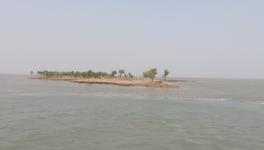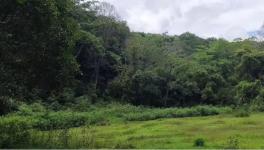Are Protected Areas The Domain Of Wildlife Or Humans?

A few days ago, the Goa bench of the Bombay High Court issued notice to several ministries related to the environment, railways, power and roads and highways.
The notice was related to a Public Interest Litigation filed by the Goa Foundation, an environmental NGO, challenging the proposed alignment of three infrastructure projects passing through the Bhagwan Mahaveer Wildlife Sanctuary and Mollem National Park in South Goa. Both of them are protected areas under Section 24A of the Wildlife Protection Act, 1972.
There are three projects on the anvil. One of them is the South Central Railway project of doubling of the existing railway line from Castlerock, in Karnataka to Vasco city in Goa. The second one is a project of the Ministry of Roads and Highways to set up a four-lane road from Belgavi, in Karnataka to Panaji in Goa. The third is a Ministry of Power project to set up a high tension transmission line from Dharwad in Karnataka to Mapusa in Goa.
The stated objectives of the projects are economic development, speedy transport, increased opportunities for tourism and so on. All of them are supposedly for the benefit of the people of Goa and Karnataka.
How do these projects affect wildlife and the residents around the wildlife sanctuary? Together, the three projects require diversion of approximately 170 hectares of forest from the protected area and the felling of approximately 37,000 trees. But these are only official figures. It may be much more.
Admittedly, during the construction period, more of the protected area would be damaged and destroyed. Significantly, the three projects criss-cross different parts of the Wildlife Sanctuary which means that allowing them to be constructed will not just adversely affect the wildlife and its habitat but will also destroy forever the integrity of this protected area.
No development work has occurred as yet within the protected area, but land acquisition proceedings and illegal felling of trees have commenced on the alignments in villages outside the Wildlife Sanctuary.
The High Court has directed the authorities to file their replies within four weeks and has given liberty to the petitioner to move the court in case of any change in circumstances.
The highway project is for widening the existing highway from 12 to 24 metres. However, due to the difficult terrain in the protected area, the proposal is to construct the extended highway on viaducts in places where expansion of the existing road is not possible. Construction on viaducts really means constructing a new road altogether.
The transmission line is proposed in the stretches of the Wildlife Sanctuary for 3.5 km, but it requires a width of 46 metres throughout due to the erection of high tension wires. The doubling of the railway line is along the existing line which was constructed way back in over 120 years ago long before this area was notified as a protected area.
Two of these three projects were recommended by the newly constituted State Wildlife Board in December 2019 which was being apprised of them for the first time, quite surprisingly by the Chief Wildlife Warden, at a meeting called by the Chief Minister at his residence. Neither were the Environment Impact Assessments for the projects circulated in advance to the members nor were the Impact Assessment reports of the Deputy Conservator of Forests discussed during the meeting. While the EIAs gloss over the environmental impacts of these projects on the protected area, as most EIAs tend to do nowadays the reports of the Deputy Conservator of Forests (DCF) were sharply critical of the impact of these projects on the protected area.
However, the DCF shockingly ended up recommending each of the projects on the grounds of “economic importance” for the state.
Such considerations, however, are against the stringent provisions of Section 29 and Section 35(6) of the Wildlife Protection Act, 1972, which categorically prohibit any destruction of, or interference with the wildlife habitat, unless this is necessary for the improvement and better management of the wildlife therein.
Pursuant to the State Board meeting, six of its expert members protested in writing about the haste with which a large number of projects including those in the wildlife sanctuary was cleared without adequate discussion and agenda notes and reports being given to the members. However, the protests were ignored and the State Board’s recommendation for the projects was forwarded to the National Board for Wildlife (NBWL). However, a greater farce awaited there.
The NBWL was constituted in 2014 but it has not met even once in the past six years. In the meantime, a Standing Committee which was constituted by the Ministry of Environment at the same time as the earlier NBWL was constituted, has continued to function and, in fact, act as the NBWL.
The Supreme Court, while setting aside the constitution of the earlier NBWL, had allowed the Standing Committee to continue, but noted that its decisions would not be acted upon. Now it appears that only the Standing Committee has become a permanent Stand-In Committee for the NBWL, while the latter has fallen into disuse. A strange situation indeed.
On 7th April 2020, during the time when the country was in the grip of a terrifying health emergency like the COVID-19 pandemic, a meeting of the Standing Committee of the NBWL was held, via video conferencing, wherein an agenda of over 50 items was considered. Two of these were the Highway Project and the Transmission Line Project from Goa. The Railway project had already been earlier approved by the Standing Committee at its meeting held in December 2019. The Hindu quoted one of the experts saying, “In a virtual conference, it’s difficult to scrutinise maps that show the location of the proposed projects. There was also no occasion to ask questions of officials for clarifications.” The projects were thus easily approved on the grounds that they were recommended both by the State Board and the Chief Wildlife Warden (CWW).
But did the CWW actually approve the projects?
As per Section 29 of the Wildlife Protection Act, the CWW is mandatorily required to issue a permit for the development works, affirming that the projects are necessary for the improvement and better management of the wildlife therein. No such permit had been issued. On the other hand, it is the CWW who presented the projects to the members at the State Board Meeting and also participated in the meeting of the Standing Committee of the NBWL. The impression is therefore given that the projects have his approval, but impressions cannot be treated as compliance with the law.
After all, the Wildlife Protection Act was specially enacted because India’s wildlife areas were found to be on a rapid decline. Thereafter, the Act was amended several times to strengthen it and give statutory status to the NBWL. Later, in 2006, the National Tiger Conservation Authority (NTCA) was also given statutory status.
In the case of the Goa projects, the NTCA has been totally ignored both by the State and National Wildlife Boards while considering approval to these projects, probably as this protected area was not yet declared a tiger reserve. On account of several sightings of tigers by the Forest Dept in Goa’s Mhadei Wildlife Sanctuary, plus the poisoning to death of four tigers in January this year, an inquiry was conducted by the NTCA, following which a fresh recommendation was made to the Goa government to declare the four WLSs (including the Bhagwan Mahavir) which form a common corridor along the Western Ghats, as a Tiger Reserve. But the State government is stubbornly resisting the proposal. The Goa Foundation has filed a PIL for the declaration of the tiger reserve as well.
It must be noted that while in Goa, the forest and wildlife authorities have been extremely casual and careless in their protection of the protected areas, Karnataka has firmly protected the Anshi-Dandeli Wildlife Sanctuary which is also a tiger reserve through which these three projects are also slated to cross. The Bhagwan Mahavir Wildlife Sanctuary, in fact, borders the Anshi Dandeli Wildlife Sanctuary.
In the case of the highway project, the National Highway Authority of India, which is the agency constructing the highway in the Karnataka sector, has decided that no widening of the highway would happen within the Wildlife Sanctuary and the original width of 12 meters would be maintained. As regards the transmission line, the Forest Dept has denied permission for its construction through the Wildlife Sanctuary on the grounds of mass destruction that will be caused.
As for the doubling of the railway line, the NBWL is awaiting the decision of the NTCA. Quite obviously, Karnataka takes the protection of its wildlife and forest areas far more seriously than Goa. Recently, even Maharashtra has refused permission for a road through the Melghat Tiger Reserve.
The impending construction of these projects has gripped the State of Goa like never before. Most interesting is that a vociferous campaign to shelve all three projects has emerged in Goa, created and propelled by the younger generation. For this reason, the campaign has taken an extremely creative and colourful turn. Musicians are now singing about Mollem, there is a Facebook page (Save Mollem) and an Instagram MyMollem account.
A good number of webinars, all handled by young lawyers and environment and wildlife professionals, have been held. There is a poster exhibit, artists are celebrating Mollem by visiting the area and drawing sketches and cartoons. The campaign is thus more vivacious and energising than court proceedings. But eventually, both will be required if Mollem is to be saved for future generations from the thoughtless and hypocritical actions of the present one.
(Norma Alvares is an advocate practicing chiefly at the Panaji Bench of the Bombay High Court at Goa. She argues Public Interest Litigations only for NGOs and activists, chiefly pertaining to the protection of the environment as well as women’s issues, children’s rights, and animal welfare. Views expressed are personal)
Get the latest reports & analysis with people's perspective on Protests, movements & deep analytical videos, discussions of the current affairs in your Telegram app. Subscribe to NewsClick's Telegram channel & get Real-Time updates on stories, as they get published on our website.























